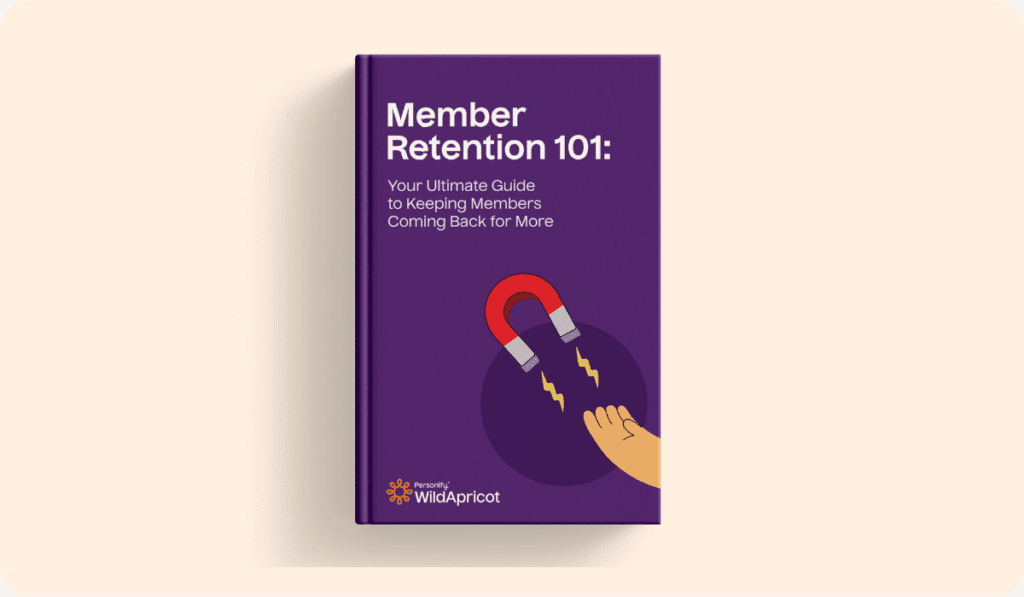Frequently, organizations focus on increasing the size of their membership rather than retention. Why? Having more voices, hands and of course, finances will allow you to achieve your goals, whether that be improving your community, raising awareness, fundraising, the list goes on.
However, member retention should be a large part of your organization’s membership strategy. Retaining members is cheaper than finding new ones and long-term members tend to be highly engaged and extremely passionate about your mission.
Why Does Member Retention Matter?
Retaining your members is key to ensuring the long-term survival of your organization. Did you know that the median renewal rate of members is 85%? Where does your organization fall for membership retention?
Member retention does this for your organization:
- Saves the money that would be spent on new member acquisition
- Provides consistent stream of revenue
- Builds a robust community
But how can you make sure you’re providing enough value so that they’ll continue to stick around?
To help you out, I’ve put together the Ultimate Membership Renewal Guide with data and helpful tips to improve your membership renewal strategy.
When it comes to retention, here are fifteen of the top ways to retain your members that you can try today!
1. Assess the Value of Your Current Benefits Package
Being a member of your organization comes with a lot of perks! You may offer special discounts, exclusive merch or content, access to events, networking opportunities and more. It’s important that you audit this yearly to ensure your organization can financially maintain these benefits and that your members are happy with what is being offered.
In your assessment ask yourself these questions:
- Are any membership tiers going untouched? Membership tiers are a great way to offer options to individuals wanting to be a member with different financial situations.
- Is it costing you too much to maintain these benefits? Are you able to cover the cost of discounts, events and merch with member dues?
- How is member engagement looking? Are your members utilizing their benefits and attending events and meetings?
- What do your members have to say? Send out yearly surveys to ask your members directly – how do they enjoy being a member? Do they like the benefits package you provide?
Never be afraid to pivot! If your current package isn’t working, change it up to see results.
2. Hone in on Your Target Audience(s!)
Take the time to make member profiles and define the member segments your organization has. From this information you’ll be able to design the perfect membership tiers and utilize targeted marketing. If you aren’t using targeted marketing already it’s the best way to obtain and retain members by highlighting the things members truly care about.
Here’s a couple classic examples of segments in your organization and how they might behave:
- New members: curious individuals who are learning about your organization. It’s important to offer them a lot of opportunities and make them feel welcome.
- Long term members: highly engaged individuals who are advocates for your organization. Ensure that you keep these members engaged by putting on events and giving a lot of appreciation.
- Lapsed members: disengaged individuals who have maintained their membership but don’t participate in things with your organization. To bring these members back, try to re-engage with quarterly updates and highlight your benefits.
3. Offer a More Accessibly Priced Membership Level
Sometimes members leave because they don’t feel they’re getting their worth from the dues they pay. One easy thing you can do to keep these members active is to create a new membership level within your membership model. This new membership level could be at a lesser price but still have some core benefits that members value.
For example, you could offer access to only the member directory for a small monthly fee. You can also create a “Friend” level which only allows access to monthly meetings. This allows these lower tiered members to still have access to some core resources, but at a price that works for them. Having a budget friendly membership level shows your organization is compassionate about financial struggles and cares about fostering a sense of community for everyone.
4. Create a Robust Welcome Package
Have you ever purchased something only to feel dissatisfied with it immediately afterwards? That’s called Buyer’s Remorse. Sometimes this happens to new members when they sign up, but don’t get the attention they expect.
Lowell Aplebaum, Senior Director of Membership for The Society of Neuroscience offers a solution: “a robust, vibrant welcome stream is one of the strongest investments an organization can make in keeping its members.”
This welcome stream helps educate the member about the services and resources they can access and point them in the right direction for the questions they have (but may be too shy to ask). New members will feel much more confident about their decision to join.
Here are six elements a great new member welcome package includes:
- A personalized message from a real person at your organization
- A brief introduction on the background of your organization
- A list of member benefits they can now access
- Links to helpful resources on your website
- A clear description of what will happen next, like an invitation to an event, or a heads up to look out for the next newsletter
- A special gift like a piece of merchandise that shows off your organization. Consider t-shirts, mugs, keychains or stickers with your name on it.
In fact, we’ve put together a complete guide on how to welcome new members because of how important it is when it comes to member retention.
5. Prioritize Onboarding!
Onboarding should be a huge priority for your organization. This is the first impression your members have with your org and you want to give them all the resources they need to feel welcome and appreciated.
Your onboarding plan should include these things:
- A welcome packet
- New member meeting
- Connection to a mentor
- New member highlight on your website and socials
- Access to member benefits and resources
The Membership Marketing Benchmark Report shows that 38% of associations expanded or refreshed their onboarding initiative in the past year. Refreshing parts of your membership lifecycle is positively correlated with increases in membership, new member acquisition and membership renewals. Continue improving your onboarding experience for new members by asking members for feedback through surveys.
The bottom line is that member retention starts with a good member onboarding experience — if you can impress your members from the second they join your organization, they’ll be more likely to stick around for the long haul.
Read more: Designing an Effective New Member Onboarding Process: 7 Tips
6. Actively Foster Community
We know that one of the most powerful reasons why people join and volunteer with any organization is for the social aspects. A sense of shared purpose. A sense of connection, in this increasingly wired but humanly disconnected world. Your organization brings this and more with membership.
There are multiple ways you can foster community for your members, making them feel included and appreciated.
- Provide a member directory. New and old members can access this to see who they can connect with in one convenient location.
- Welcome luncheons. Have a big welcome lunch for your new members to meet existing members in a casual environment. Plus who doesn’t love a good meal!
- Volunteer days. Providing opportunities for your members to benefit your community and connect with one another is a great way to foster inclusion.
- Mentorships. A mentorship program allows new and old members to bond with one another. Newer members will feel welcomed and older members will be able to share their wealth of knowledge and get to know fresh faces.
7. Provide Special Resources
Your members need to see the value that your organization brings them. It’s important to provide resources to them that matches the money they spend on membership.
Consider providing these special resources to members:
- Educational resources. Whether these are documents on your website or information given in weekly or monthly newsletters, it’s important to include education for your members. With a special member login you can house all educational materials so only members can have access.
- Professional development certification. Many individuals join organizations for professional development. Provide opportunities for you members to grow with certifications and seminars that your members will appreciate.
- Mentorships. As we mentioned previously, mentorship can foster a sense of community among your members and provide immense value. Newer members need to feel guided in your organization and older members want to share their knowledge.
- Webinars. A cost effective way to provide value to your members is hosting webinars. These allow everyone to gain the education you’re providing plus you can record these and save them on your website for members to view on demand after the live event.
Providing valuable resources like these shows how much your organization brings and why a membership is worthwhile to retain.
8. Run Awesome Events
Events are probably one of the biggest reasons your members joined your organization. They bring your members together and allow everyone to have a good time being social. These events could be anything from a simple happy hour to a large event with speakers, entertainment and a fancy dinner.
Here’s a couple examples of events to wow your members:
- Potluck dinner
- Happy hour at a local watering hole
- Barbeque at the park
- Lake or pool party
- Have a speaker come to inspire or educate
- Attend a local festival or carnival
- Painting or cooking class
- Catered dinner
Hopefully those ideas got you inspired, but don’t forget about the power of virtual events. This could be anything from educational sessions to trivia or even a virtual happy hour.
9. Consistently Seek Feedback
Happy members = retained members. But how will you know if they’re happy without hearing their feedback? Utilizing member surveys gives you the chance to address any long-term issues and let your members feel heard.
This survey could be focused on specific questions or a scale of how a member feels about areas of your organization’s membership.
Some of the subjects your membership satisfaction survey could cover include:
- Benefits of membership
- General satisfaction
- Meeting times, frequency, and duration
- Barriers to participation
- Ideas for improvements
- Topics of most and least interest
Don’t forget to add a section for comments and feedback that wasn’t covered by your survey!
Read more: Why Your Organization Needs a Member Satisfaction Survey + 20 Questions
10. Automate Renewals
The ability to automate membership renewals is one of the best things you can do to improve member retention. The Membership Marketing Benchmark Report states that 32% of members did not renew their membership because they forgot. If their membership was automatically renewed for them, this problem would cease to exist.
Your membership management software should be able to do this for you. WildApricot (that’s us!) has the ability to automate your membership renewals and automatically process member dues from our all-in-one management software. Try a 60-day free trial to see how it can impact your member retention.
11. Tap into the Power of Membership Management Software!
If you’re still collecting member information on paper, taking cash and checks for dues, and communicating with your members via snail mail, there’s a good chance you’re actually pushing people away. Technology is constantly changing our behavior, and nowadays people have a much shorter attention span and expect instantaneous results.
Unfortunately, if your organization isn’t keeping up with technology, it’s falling behind, and any other organization using the latest tech will naturally attract more people (especially the younger generations). Fortunately, there are simple software solutions designed to modernize any membership organization quickly and easily.
This type of software is called Membership Management Software, and using it, your organization can:
- Offer online registration for membership and events.
- Allow members to access and update their profiles.
- Instantly process payments and invoices online.
- Improve member communication through automated emails, newsletters, reminders, and invoices.
- Build a professional-looking website complete with member directories, event calendars, downloadable resources, a blog, and more.
- Create a full contact database that’s easy to search, filter, and update.
- Access financial reports, analytics, and membership summaries in seconds.
- and more.
If you think your organization could benefit from using this type of software, try WildApricot for free with a 60-day trial! You’ll experience a more streamlined process and cultivate a better member experience.
12. Show Member Appreciation
Member appreciation is something many organizations can forget about and it’s a huge reason members leave. Members want to feel engaged with and know that their contributions to the organization are recognized.
You can appreciate you members in a variety of ways. Consider putting on appreciation events. Highlight the impact your members have made to the organization through a special dinner, lunch, party or trip.
Sending out thank you messages is a simple but effective way to show your members you care about them. This could be a physical card you mail to them, an email or even a shout out on social media.
Member spotlights are another great way to highlight members and make them feel special. This can be done on your website or social media to feature members. Spotlight new members, members who have hit special milestones like and anniversary or volunteer goal and members who have done something cool in their personal lives.
Read more: 10 Member Appreciation Day Ideas + 6 Quick Steps to Show You Care!
13. Offer the Option to Pause Membership
Sometimes, members just aren’t in the position to continue paying for or using your membership.
This is particularly true during periods of recession, during which many households are experiencing additional financial strain or might not be able to take part in activities due to additional care responsibilities.
But instead of only allowing them to cancel, why not give them the option to pause their membership? That way, they can continue to receive updates and remain part of your community. When they can participate in your membership again, they’ll feel more motivated to do so.
On your side, you’ll still have a record of their membership, so that you won’t have to learn all about them from scratch a second time.
PS: If you’re already using WildApricot, here’s how you can do this.
14. Give Lapsed Members a Special Offer
Have you ever abandoned your online shopping cart, then gotten an email asking you to check out and reconsider with an additional discount code? This is an incredibly effective tactic so why not create something similar for your membership?
The idea here is to send unengaged, or lapsed members something enticing to re-engage them.
Here are some ideas:
- A discount on one month of membership
- Limited-time free access to your resources
- A free invite to an event
- Free merchandise
- Access to higher tiered member events or resources
If you choose to go the discount route, research by Marketing Land found that win-back offers that included dollar-off discounts worked 200% better than offers with percent discounts.
15. Run an Exit Interview
Have you ever left a job and been asked for an exit interview? The reason exit interviews so important is because employers can learn valuable information that can be used to improve staff retention. This same principle applies to membership organizations. When a member leaves, ask them if they’d like to share why they have chosen to leave.
Some of the most common reasons include:
- They actually just left the industry
- They don’t feel engaged enough
- They’re not getting enough value out of your membership
- They think it’s too expensive
- They simply forgot to renew (which is a great opportunity to remind them!)
These insights are vital for your member retention strategy! If you notice any trends in the member feedback you collect, it’s a good idea to change things around so more members don’t leave. Plus, you might be able to attract old members back.
If You’d Like More Ways to Increase Member Retention…
If you’d like more sure-fire strategies on how to keep your members longer, check out our e-book, The Ultimate Guide to Member Retention.
Or, if you’d just like some more quick tips, check out our article called Your Complete Guide To Increase Member Engagement.
Remember: retaining your membership isn’t just a one-time activity. It should be something that’s kept in mind throughout the whole member lifecycle, not just when it’s renewal time.
To keep members around for the long haul, you should be focusing on building better relationships with them from day one.
All the best with retaining your membership!











